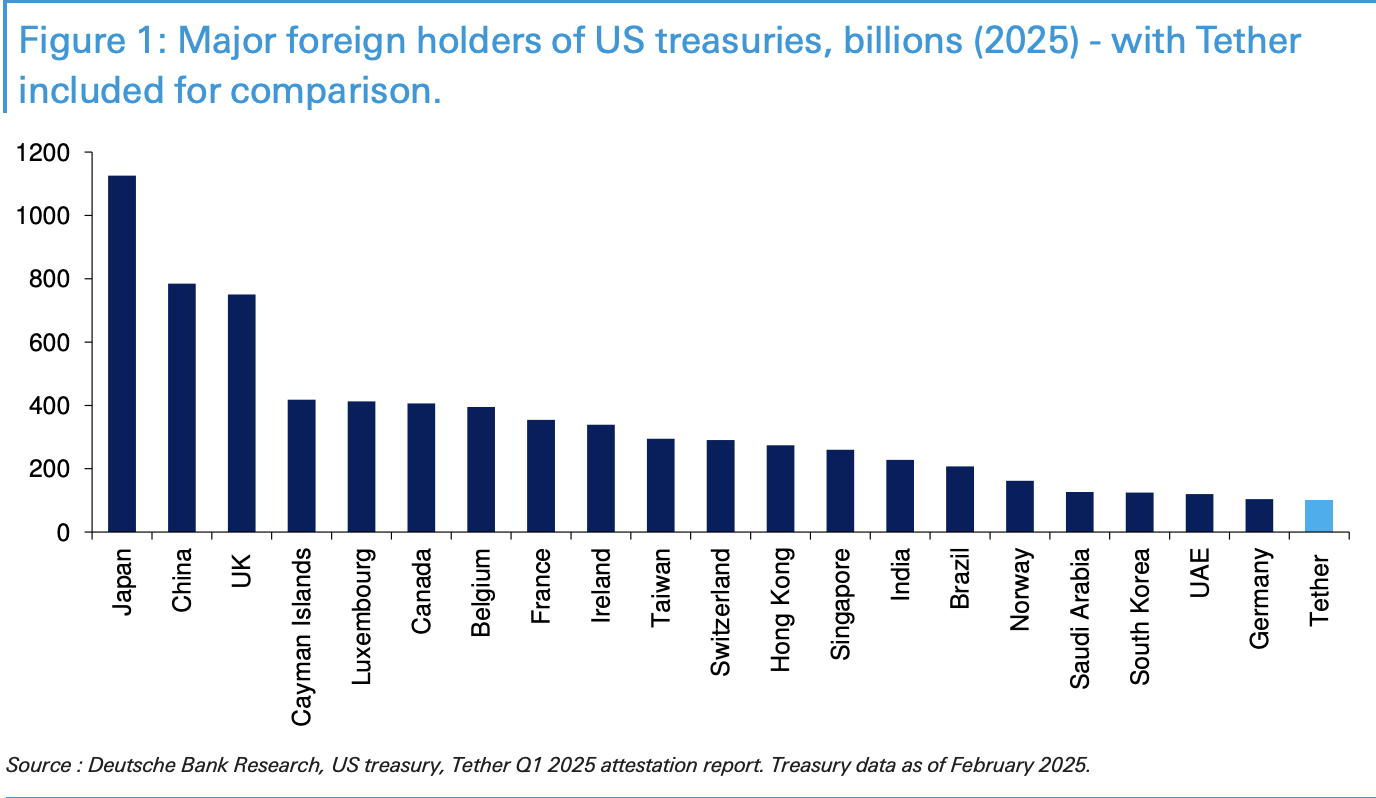Author: Zhao Ying
With the US dollar hegemony wavering, the stablecoin market is rapidly expanding, potentially becoming a new support point for the US dollar and reshaping the global financial system?
According to Wind Trading Desk, Jim Reid, Global Head of Macro and Thematic Research at Deutsche Bank, mentioned in his latest report that stablecoins are expanding at an unprecedented speed, and corporate finance executives have felt the wave of transformation. Reid stated:
This week, I attended a corporate finance conference on the US West Coast, and all finance directors noticed the increase in stablecoin transactions in their businesses, which is a growing market.
So-called "stablecoins" are digital assets, with over 99% of stablecoin market value pegged to the US dollar, effectively playing the role of money market funds supporting the US short-term debt market. For example, Tether has become one of the major US Treasury holders.
Currently, the US is accelerating stablecoin regulatory legislation, with payment being a major use case, and regulation may open the door to broader adoption. The recent GENIUS stablecoin bill was rejected, but Deutsche Bank expects significant progress this year.
Analysts believe the stablecoin market has enormous potential, and payment applications may lead to wider acceptance of crypto infrastructure. Citi predicts that the potential market size of stablecoins could reach $1.6-3.7 trillion by 2030 in basic and optimistic scenarios.
What are stablecoins? How do they work?
Stablecoins are digital assets used for payment, with low volatility compared to other cryptocurrencies due to their 1:1 peg to a "stable" asset. The Deutsche Bank report points out that there are four main types of stablecoins: fiat-backed, asset-backed, crypto-backed, and algorithmic.
Currently, US dollar-backed stablecoins dominate the market, with over 99% of stablecoin market value pegged to the US dollar. These stablecoins hold over $120 billion in US reserve assets, effectively acting as money market funds supporting the US short-term debt market.
Citi's report further explains that stablecoins have become an important part of the cryptocurrency ecosystem: first, they are an entry point to decentralized finance - tracking stablecoin issuance growth helps determine the overall digital asset environment's health and growth; second, stablecoins can be viewed as a store of value without the inherent volatility of native tokens.
One use case for stablecoins is reserves, with their "safe haven" characteristics increasing their attractiveness as a store of value in the current market volatility. Another potential use case is payment and cross-border transactions, with regulatory clarity potentially paving the way for broader payment adoption.
Stablecoins - A Digital Extension of US Dollar Hegemony, A New Source of Demand for US Treasuries?
Stablecoins' impact on the US bond market is increasingly expanding. Deutsche Bank data shows that
As of March 2025, Tether held $98.5 billion in US Treasuries, a figure that was almost zero in 2020 and has now become one of the major overseas holders of US debt.

Citi also notes that major stablecoin providers have become larger holders of US Treasuries:
Particularly, stablecoins pegged to the US dollar are becoming an increasingly growing source of demand for US Treasury bills. The two main reasons proposed by the US Secretary of Commerce and Treasury Secretary for legislation are: increasing demand for short-term government bonds and strengthening the US dollar's status as a global reserve currency.
Large stablecoin providers, such as Tether, have become significant holders of US Treasuries. Proposed legislation requiring stablecoin holders to hold short-term US Treasuries creates a new source of demand for US short-term debt.
However, Citi's analysts also pointed out two mitigating factors: first, if any fund inflows come from existing US Treasury holders, directly or indirectly, the demand effect would be diminished. For example, funds moving from money market funds to stablecoins would represent a substitution but not a net effect on overall demand. Second, while supporting short-term demand, long-term debt demand may not be affected.
Stablecoins are becoming increasingly important in the digital US dollar infrastructure, with Deutsche Bank stating:
It is most in the US's interest to increase stablecoin demand, thereby strengthening the dollar, especially as stablecoin adoption accelerates, making it an attractive store of value due to its "safe haven" characteristics in the current market volatility.
Citi's report noted:
The US dollar still dominates in foreign exchange reserves, and the dominance of US dollar stablecoins stems not just from first-mover advantage but reflects the dollar's "exorbitant privilege" as the preferred reserve currency. The stablecoin market has enormous potential, with Citi estimating it could reach $1.6 to $3.7 trillion by 2030.
Meanwhile, Citi warns that since the launch of euro stablecoins under the European MiCA legislative framework, non-US dollar stablecoin market value has increased, coinciding with the dollar's weakness and cracks in the "American exceptionalism" narrative. Although euro-based stablecoins currently occupy a small share, changes in this area could be a forward-looking indicator of shifts in the dollar's status.
US Stablecoin Legislation Accelerating
The US is accelerating stablecoin regulatory legislation. According to media reports, the Senate's GENIUS bill did not reach a full vote stage but is expected to gain bipartisan support. The House bill has passed committee and awaits a full house vote.
The Deutsche Bank report indicates that the US is currently accelerating efforts to establish a regulated, US dollar-backed stablecoin ecosystem by August this year. The GENIUS stablecoin bill was recently rejected but is expected to make significant progress this year.
Citi Bank's analysis shows two stablecoin bills currently in the US legislative process: the House's STABLE bill and the Senate's GENIUS bill. Both have similar provisions for consumer protection and reserves but still have differences that need coordination and revision.
Both bills focus on payment functions, so-called "payment stablecoins," and include provisions related to anti-money laundering (AML), national security, consumer protection, and reserve requirements. Reserve requirements involve 1:1 use of short-term US dollar Treasuries and insured deposit repurchases.
Analysts believe that a stable regulatory environment will clear the path for widespread stablecoin adoption, with the payment sector becoming a key use case for stablecoins.





